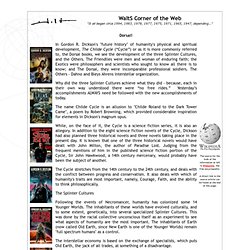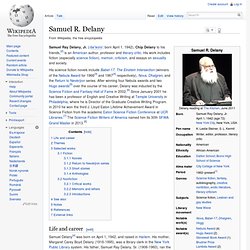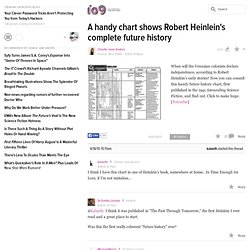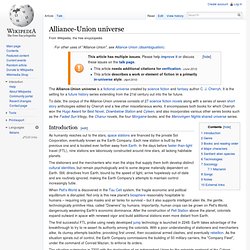

Future history. SF Signal: Do You Know Your Future History? (Part 1) Science Fiction Future. The reference site for Kim Stanley Robinson - KimStanleyRobinson.info. Quirky SF Future Histories. Vernor Vinge. Gordon R. Dickson's Dorsai. Dorsai!

In Gordon R. Dickson's "future history" of humanity's physical and spiritual development, The Childe Cycle (“Cycle”) or as it is more commonly referred to, the Dorsai books, we see the development of the three Splinter Cultures, and the Others. The Friendlies were men and woman of enduring faith; the Exotics were philosophers and scientists who sought to know all there is to know; and The Dorsai, they were incomparable professional soldiers. The Others - Dahno and Bleys Ahrens interstellar organization. Why did the three Splinter Cultures achieve what they did - because, each in their own way understood there were “no free rides.” The name Childe Cycle is an allusion to "Childe Roland to the Dark Tower Came", a poem by Robert Browning, which provided considerable inspiration for elements in Dickson's magnum opus. While, on the face of it, the Cycle is a science fiction series, it is also an allegory.
Samuel R. Delany. Samuel Ray Delany, Jr.

(/dəˈleɪni/; born April 1, 1942), Chip Delany to his friends,[2] is an American author, professor and literary critic. His work includes fiction (especially science fiction), memoir, criticism, and essays on sexuality and society. Life and career[edit] The family lived in the top two floors of a three-story private house between five- and six-story Harlem apartment buildings. Delany envied children with nicknames and took one for himself on the first day of summer camp, at about age twelve, by answering "They mostly call me Chip" when asked his name.[2] Decades later Frederick Pohl called him "a person who is never addressed by his friends as Sam, Samuel or any other variant of the name his parents gave him. Cordwainer Smith and His Remarkable Science Fiction. Early Future Histories. THE OLAF STAPLEDON ONLINE AR - Classic SF Future Histories. A handy chart shows Robert Heinlein's complete future history. @earthclanbootstrap: Yowza.

First saw this in ' The Past Through Tomorrow' (purchased in the 70's... I ain't that old) @earthclanbootstrap: Regardless of my opinion of Heinlein's politics, I've always had a high level of respect for his ability to have been able to pull off his Future History as well and coherently as he did. May others that have come after him have proven exactly how hard it is to keep things mostly consistent and true to 'spec' for something that big, in their failures.
@lazyeight: That actually may have been where I first came across it; for me it would have been the early/mid-eighties. @Merricat: His attention to detail in that regard was pretty remarkable. As far as his politics goes, as I've gotten older I've slowly begun to suspect that he was maybe just taking the piss a little bit. The very underage girl stuff, however, still creeps me out. The Dune Encyclopedia - Dune Wiki - Frank Herbert, David Lynch, Sandworms. The Dune EncyclopediaThis article or section refers to elements that appear exclusively in The Dune Encyclopedia.

The Dune Encyclopedia is an expansion of the Dune universe, background and commentary in the form of a reference text compiled and edited by Dr. Willis E. McNelly in 1984. A total of 43 people contributed articles to the work. Classic Fantasy and Science Fiction. Hainish Cycle. The Hainish Cycle consists of a number of science fiction novels and stories by Ursula K.

Le Guin. It is set in a alternate history/future history in which civilizations of human beings on a number of nearby stars, including Terra (Earth), are contacting each other for the first time and establishing diplomatic relations, setting up a confederacy under the guidance of the oldest of the human worlds, peaceful Hain. In this history, human beings did not evolve on Earth but were the result of interstellar colonies planted by Hain long ago, which was followed by a long period when interstellar travel ceased. Some of the races have new genetic traits, a result of ancient Hainish experiments in genetic engineering, including a people who can dream while awake, and a world of androgenous people who only come into active sexuality once a month, and can choose their gender. Sequence of writing[edit] Alliance-Union universe.
The Alliance-Union universe is a fictional universe created by science fiction and fantasy author C.

J. Cherryh. It is the setting for a future history series extending from the 21st century out into the far future. To date, the corpus of the Alliance-Union universe consists of 27 science fiction novels along with a series of seven short story anthologies edited by Cherryh and a few other miscellaneous works. It encompasses both books for which Cherryh won the Hugo Award for Best Novel, Downbelow Station and Cyteen, and also incorporates various other series books such as the Faded Sun trilogy, the Chanur novels, the four Morgaine books, and the Merovingen Nights shared universe series. Introduction[edit] As humanity reaches out to the stars, space stations are financed by the private Sol Corporation, eventually known as the Earth Company.
Welcome to Joan Vinge's page. Science Fiction Timeline Site . . . Larry Niven's Known Space . . .